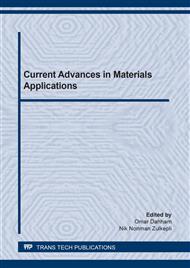[1]
P. P. Bansal, M. Kumar, and S. K. Kaushik, Effect of Wire Mesh Orientation on Strength of Beams Retrofitted Using Ferrocement Jackets, International Journal of Engineering, 2 (2008) 8-19.
Google Scholar
[2]
M.F. Belal, H. N. Mohamed, and S. Mourad, Behavior of Reinforced Concrete Columns Strengthened by Steel Jacket, HBRC Journal 11, (2015) 201–212.
DOI: 10.1016/j.hbrcj.2014.05.002
Google Scholar
[3]
Jodawat A., Parekh, B. Marathe, K. Pawar, S. Patwa, Y. Sahu, and I. Jain, Retrofitting of Reinforced Concrete Column by Steel Jacketing", Int. Journal of Engineering Research and Application, 6 (2016) 1-5.
Google Scholar
[4]
H. Shrestha, S. Pradhan and R. Guragain, Experiences on Retrofitting of Low Strength Masonry Buildings by Different Retrofitting Techniques in Nepal, National Society for Earthquake Technology-Nepal (NSET), WCEE 15, LISBOA, (2012).
Google Scholar
[5]
Y.T. Obaidat, S. Heyden, and O. Dahlblom, G. Abu-Farsakh, and Y. Abdel-Jawad Retrofitting of Reinforced Concrete Beams Using Composite Laminates, Construction & Building Materials, 25 (2011) 591-597.
DOI: 10.1016/j.conbuildmat.2010.06.082
Google Scholar
[6]
M. M. Rasheed, Retrofit of Reinforced Concrete Deep Beams with different Shear Reinforcement by Using CFRP, Journal of Civil and Environmental Research, 8 (2016) 6-14.
Google Scholar
[7]
F. J. Vecchio F. and Bucci, Analysis of Repaired Reinforced Concrete Structures", Journal of Structural Engineering, 125 (1999) 644-652.
DOI: 10.1061/(asce)0733-9445(1999)125:6(644)
Google Scholar
[8]
R. Wong and F. J. Vecchio, Accounting for Debonding in the Analysis FRP-Repaired Structures, FRP Composite in Civil Engineering, 1 (2001) 625-632.
Google Scholar
[9]
R. Santhakumar, E. Chandrasekaran and R. Dhanaraj, Analysis of Retrofitted Reinforced Concrete Shear Beams using Carbon Fiber Composites, Electronic Journal of Structural Engineering, 4 (2004) 66-74.
DOI: 10.56748/ejse.442
Google Scholar
[10]
F. Izzet, Retrofit of Shear Critical R.C. Beams with Carbon Fiber Reinforced Polymer Sheets, Ph. D Thesis, University of Technology, Baghdad, Iraq (2008)152.
Google Scholar
[11]
Y.T. Obaidat, S. Heyden, and O. Dahlblom, The Effect of CFRP and CFRP/ Concrete Interface Models when Modeling Retrofitted RC Beams with FEM, Composite Structures, 92 (2010) 1391–1398.
DOI: 10.1016/j.compstruct.2009.11.008
Google Scholar
[12]
Y.T. Obaidat, S. Heyden, and O. Dahlblom, FEM Study on the Effect of CFRP Stiffness and Width on Retrofitted Reinforced Concrete Beam Behaviour, Structural Retrofitting of Concrete Beams Using FRP, (2011).
DOI: 10.1016/j.compstruct.2009.11.008
Google Scholar
[13]
S. M. Hoseyni, M. Shakouri, Verifying the Effect of Element Birth and Death Technique on Stress Distribution in Cracked Area, Journal of Automotive and Applied Mechanics. 3 (2015) 13-16.
Google Scholar
[14]
M. Jaroniek andT. Niezgodzinski, Element Birth and Death Method Application to Lamellar Crack Analysis, Mechanics and Mechanical Engineering, 19 (2015) 63–75.
Google Scholar
[15]
B.L. Hu, Q. H. Zhang, F. Wang and J. H. Zhang, FEM Analysis of EDM in Gas Based on Birth and Death of Element, Materials Science Forum, 626 (2009) 599-604.
DOI: 10.4028/www.scientific.net/msf.626-627.599
Google Scholar
[16]
ANSYS, ANSYS Release 17.0, Finite Element Analysis System, SAS IP, Inc, (2016).
Google Scholar
[17]
K. J. Willam and E. P. Warnke, Constitutive Model for Triaxial Behaviour of Concrete, Seminar on Concrete Structures Subject to Triaxial Stresses", International Association of Bridge and Structural Engineering Conference, Bergamo, Italy, (1974) 174.
Google Scholar


